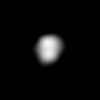 | |
| Descubrimiento | |
|---|---|
| Descubierto por | Stephen P. Synnott / Voyager 2 |
| Fecha | 13 de enero de 1986 |
| Características orbitales | |
| Semieje mayor | 75,255.613 ± 0.057 km[1] |
| Excentricidad | 0.00013 ± 0.000073[1] |
| Periodo orbital | 0.623527470 ± 0.000000017 d d[1] |
| Inclinación | 0.03063 ± 0.028° (en el ecuador de Urano)[1] |
| Satélite natural de | Urano |
| Características físicas | |
| Diámetro principal | 81 km |
| Masa | ~3x618 kg[2] |
| Superficie | ~25.000 km²[2] |
| Densidad media | 1,3 g/cm³[3][4] |
| Gravedad superficial | ~0.014 m/s²[2] |
| Velocidad de escape | ~0.034[2] |
| Periodo de rotación | |
| Inclinación axial | cero[5] |
| Albedo | 0.08 ± 0.01[6] |
| Temperatura | ~64 K[2] |
Belinda es un satélite natural de Urano. Fue descubierto el 13 de enero de 1986 por la sonda Voyager 2 y su designación provisional fue S/1986 U 5.[7] Debe su nombre a Belinda, la heroína de la obra The Rape of the Lock de Alexander Pope. También es llamado Uranus XIV.[8]
Belinda pertenece al Grupo Porcia de satélites, que también incluye a Bianca, Crésida, Julieta, Porcia, Rosalinda, Cupido, Desdémona y Perdita.[6] Estos satélites tienen órbitas y propiedades fotométricas similares.[6] Por desgracia, aparte de los datos de su órbita,[1] su radio de 45 kilómetros,[5] y el albedo geométrico de 0,08,[6] prácticamente no se sabe nada de él.
En las imágenes enviadas por el Voyager 2, Belinda aparece como un objeto alargado, con el eje principal apuntando hacia Urano. Su superficie es de color gris.[5]
-
Esquema del sistema de Urano.
Véase también
Referencias
- ↑ a b c d e Jacobson, R.A. (1998). «The Orbits of the Inner Uranian Satellites From Hubble Space Telescope and Voyager2 Observations». The Astronomical Journal 115: 1195-1199. doi:10.1086/300263.
- ↑ a b c d e Calculada sobre la base de otros parámetros
- ↑ «Planetary Satellite Physical Parameters». JPL (Solar System Dynamics). 24 de octubre de 2008. Consultado el 12 de diciembre de 2008.
- ↑ Williams, Dr. David R. (23 de noviembre de 2007). «Uranian Satellite Fact Sheet». NASA (National Space Science Data Center). Consultado el 12 de diciembre de 2008.
- ↑ a b c Karkoschka, Erich (2001). «Voyager's Eleventh Discovery of a Satellite of Uranus and Photometry and the First Size Measurements of Nine Satellites». Icarus 151: 69-77. doi:10.1006/icar.2001.6597.
- ↑ a b c d Karkoschka, Erich (2001). «Comprehensive Photometry of the Rings and 16 Satellites of Uranus with the Hubble Space Telescope». Icarus 151: 51-68. doi:10.1006/icar.2001.6596.
- ↑ Smith, B. A. (January 16 1986). «IAU Circular No. 4164». Archivado desde el original el 12 de agosto de 2007. Consultado el 6 de agosto de 2006.
- ↑ «Planet and Satellite Names and Discoverers». Gazetteer of Planetary Nomenclature. USGS Astrogeology. July 21 2006. Consultado el 6 de agosto de 2006.

